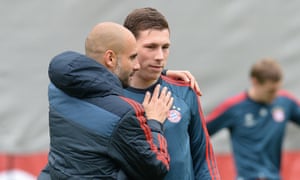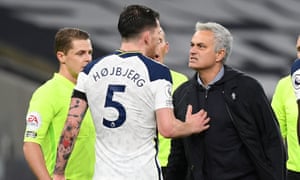Tottenham were 4-0 up in the fourth and final minute of stoppage time against Ludogorets on the Thursday before last. The Europa League tie was over. There was nothing left to play. But Pierre-Emile Højbjerg did not see it that way. The Spurs midfielder does not see it that way.
The Ludogorets substitute Ivan Yordanov had wriggled around him and he was approaching halfway. Spurs had players back. There was little on and Højbjerg, also on as a substitute, could have let him go. But he could not bear to be beaten. And so he fouled him and was booked.
It was the definition of a needless yellow card. But, at the same time, it shone a light on something more elemental, on who Højbjerg is and how he plays the game; competitive fires raging whenever the ball is in play.
José Mourinho wants to instil a mentality in which Spurs go into every game, every phase of play, every duel, believing they can win. He wants them to have a particular edge. Højbjerg has come to feel like the embodiment of it and he has been a principal driver of Spurs’s fine start to the season, which has them on top of the Premier League and sensing possibility going into Sunday’s home derby with Arsenal.
Mourinho’s top priority in the summer transfer window had been a No 6, a midfield pivot to energise a gameplan geared towards giving away no space, and Højbjerg seemed to tick all of the boxes. After four seasons at Southampton, the 25-year-old was ready for a new challenge and, having made it clear that he would not extend a contract that had 12 months to run, he was both available and within Spurs’s price bracket.
Mourinho liked Højbjerg’s pedigree, his strength of character. This was a player who had moved from FC Copenhagen to Brøndby at 14 – a ballsy decision – and been shaped at Bayern Munich from 16. He made his debut for the German club at 17 and was in their starting lineup for the 2014 DFB-Pokal final victory over Borussia Dortmund at 18.

“Eighty per cent of what I experienced at Bayern was about mentality – preparing, getting back in, knowing when to do what,” Højbjerg told the Guardian in 2018. “There was one aim: to end the season with titles. It starts on 1 July and it goes until 20 May. It’s in the blood. You get horny for titles.”
It had not been easy for Højbjerg at Southampton, where he played under four managers and the team spent a good deal of time fighting fires. They struggled for identity and cohesive direction under the first three – Claude Puel, Mauricio Pellegrino and Mark Hughes – but Højbjerg impressed with his ability to think on his feet, to take responsibility. It was plain to his teammates that he had a football education, the capacity for clear-eyed analysis, and Mourinho felt that, in the right structure, he could step up his level. But did even Mourinho expect him to make such a difference so quickly?
Højbjerg has played in every minute of Spurs’s opening 10 league games and the statistics show that he has made the third-most tackles in the division. But he gets the team playing, too. He is top of the league for number of passes made and number of passes completed, at the healthy rate of 89.4%, and he has been involved in eight sequences that have led to goals – another competition high.

As so often happens with transfers between English clubs, there was a dispute over how to publicly frame the size of the initial fee. Southampton claimed it was £20m; Spurs £15m. Either way, it looks to be a bargain.
“I think maybe him being formed at Bayern had an effect on his mentality but I also think his DNA is his own personality,” Mourinho said. “He’s a guy that works hard every day. He wants to be better every day. He wanted very, very much to join Tottenham. He’s the kind of guy that when he comes, he comes really, really happy. And he wanted to prove himself at a different level. He’s a great professional.”
Højbjerg had other options. It is well documented that Everton wanted him, and Ajax and Monaco were in the race, too. Bayern would have taken him back. He could have earned more money elsewhere. But the Mourinho factor should not be underestimated here. When the Spurs manager made his pitch, Højbjerg’s mind was made up.
Mourinho said that he did not offer him anything special, he did not make any promises. “I just said that he was going to a squad with ambitions and the way we try to play, we need that kind of player, the qualities that he has,” Mourinho added. Yet it was easy to see this as something special. Højbjerg certainly did. Mourinho wanted him to be his No 6, the player at the heart of his team.
Mourinho had realised that he needed to reshape his midfield, to instil greater security, partly to create a platform to draw the best out of Tanguy Ndombele and Giovani Lo Celso, the club’s most expensive signings. As Lo Celso has struggled for full fitness, Mourinho has been drawn to the industry and leadership of Moussa Sissoko.
Many Spurs fans would like to see Højbjerg and Lo Celso start with Højbjerg in a slightly more attack-minded lineup but, at the moment, it feels like an either/or selection for Mourinho. One thing is clear. Mourinho’s midfield has evolved completely from the one he first used when he took over last November, which was Eric Dier and Harry Winks behind Dele Alli. Dier has been moved back into central defence; the other two have slipped down the pecking order.

Mourinho has long favoured a solid block – organisation and balance being key principles – and, in Højbjerg, he has found his general, a player he describes as one of his “fundamentals”, who he always needs on the pitch “in any circumstance”. Højbjerg was the only first-choice selection who played the 90 minutes in Thursday’s 3-3 Europa League draw at Lask.
Two weeks ago Spurs tweeted a photograph of Mourinho snarling into Højbjerg’s face after the 2-0 home win over Manchester City. “This, this and more of this,” read the caption. “Beast mode,” Højbjerg replied. Whatever it takes, nothing shall pass.
Source link